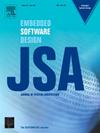StorStack: A full-stack design for in-storage file systems
IF 3.7
2区 计算机科学
Q1 COMPUTER SCIENCE, HARDWARE & ARCHITECTURE
引用次数: 0
Abstract
Due to the increasingly significant cost of data movement, In-storage Computing has attracted considerable attention in academia. While most In-storage Computing works allow direct data processing, these methods do not completely eliminate the participation of the CPU during file access, and data still needs to be moved from the file system into memory for processing. Even though there are attempts to put file systems into storage devices to solve this problem, the performance of the system is not ideal when facing high latency storage devices due to bypassing the kernel and lacking page cache.
To address the above issues, we propose StorStack, a full-stack, highly configurable in-storage file system framework, and simulator that facilitates architecture and system-level researches. By offloading the file system into the storage device, the file system can be closer to the data, reducing the overhead of data movements. Meanwhile, it also avoids kernel traps and reduces communication overhead. More importantly, this design enables In-storage Computing applications to completely eliminate CPU participation. StorStack also designs the user-level cache to maintain performance when storage device access latency is high. To study performance, we implement a StorStack prototype and evaluate it under various benchmarks on QEMU and Linux. The results show that StorStack achieves up to 7x performance improvement with direct access and 5.2x with cache.
求助全文
约1分钟内获得全文
求助全文
来源期刊

Journal of Systems Architecture
工程技术-计算机:硬件
CiteScore
8.70
自引率
15.60%
发文量
226
审稿时长
46 days
期刊介绍:
The Journal of Systems Architecture: Embedded Software Design (JSA) is a journal covering all design and architectural aspects related to embedded systems and software. It ranges from the microarchitecture level via the system software level up to the application-specific architecture level. Aspects such as real-time systems, operating systems, FPGA programming, programming languages, communications (limited to analysis and the software stack), mobile systems, parallel and distributed architectures as well as additional subjects in the computer and system architecture area will fall within the scope of this journal. Technology will not be a main focus, but its use and relevance to particular designs will be. Case studies are welcome but must contribute more than just a design for a particular piece of software.
Design automation of such systems including methodologies, techniques and tools for their design as well as novel designs of software components fall within the scope of this journal. Novel applications that use embedded systems are also central in this journal. While hardware is not a part of this journal hardware/software co-design methods that consider interplay between software and hardware components with and emphasis on software are also relevant here.
 求助内容:
求助内容: 应助结果提醒方式:
应助结果提醒方式:


